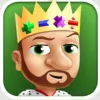Take a look inside 5 images
King of Math Junior
Pros: Kids can practice a wide range of math skills and rise in the ranks of an imaginary kingdom's social structure.
Cons: More advanced levels aren't accessible until less challenging levels are completed, which may be an issue for more advanced learners.
Bottom Line: With a fun premise and tons of good math problems, this is a solid practice tool for kids with a wide range of abilities.
In the classroom, use the King of Math Junior worksheets as post-lesson practice tools. As a class, discuss the virtual medieval society and challenge kids to earn stars and eventually assume the role of king or queen. Leaderboards can be tracked through Game Center, or you can keep your own class leaderboard. The game accommodates multiple players, so kids can share devices if needed.
King of Math Junior is a game that revolves around a virtual medieval society. As kids answer questions correctly and solve puzzles, they climb the so-called social ladder in the hopes of becoming king or queen. Practice worksheets are organized by content areas, including basic counting and addition and more advanced concepts like multiplication, division, and fractions. Each set of worksheets is called a book, and each book contains nine chapters. Kids have to earn a minimal score to unlock a chapter and move on to the next chapter. Throughout these books, kids practice addition, subtraction, number sense, geometry, multiplication, division, measurement, and fractions. In a book called "Puzzles," kids practice reasoning and critical-thinking skills.
As kids continue to earn points for correct answers, they earn stars and level up their characters from farmers to more powerful members of society. The game links with Game Center, but this setting can be turned off. A free version of the app is available, but it only contains three sets of worksheets (Counting, Addition, and Subtraction), compared to 10 sets in the full paid version.
The unique setting and objective -- answer math problems correctly and you could rule the land! -- makes King of Math Junior a fun, engaging way to get kids to practice important math skills. The content is rich, and the worksheets and scoring system fill this practice tool with meaningful learning experiences and positive rewards. Different models are used to represent many of the same types of problems: For example, addition problems are represented as standard math sentences, number cubes, and groups of fruit on plates, offering a great opportunity to reinforce comprehension for young learners. These learning opportunities would be even better if the feedback were richer; as it is, the only feedback for incorrect answers is a big red X. Richer, more detailed feedback -- and access to hints periodically -- would make this engaging experience even more encouraging for students of all abilities.













